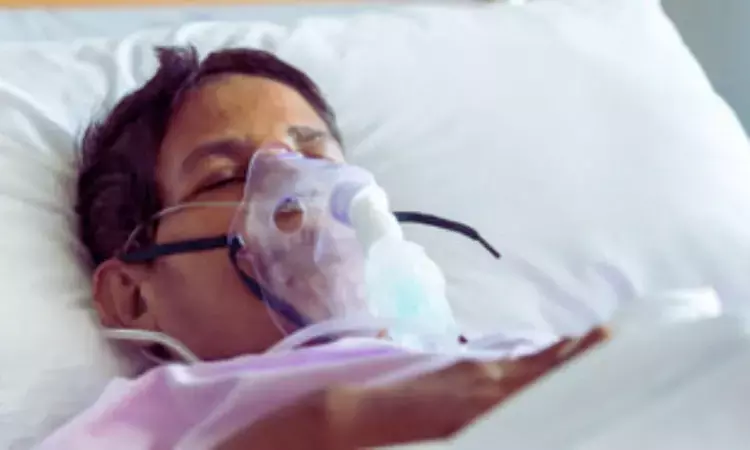- Home
- Medical news & Guidelines
- Anesthesiology
- Cardiology and CTVS
- Critical Care
- Dentistry
- Dermatology
- Diabetes and Endocrinology
- ENT
- Gastroenterology
- Medicine
- Nephrology
- Neurology
- Obstretics-Gynaecology
- Oncology
- Ophthalmology
- Orthopaedics
- Pediatrics-Neonatology
- Psychiatry
- Pulmonology
- Radiology
- Surgery
- Urology
- Laboratory Medicine
- Diet
- Nursing
- Paramedical
- Physiotherapy
- Health news
- Fact Check
- Bone Health Fact Check
- Brain Health Fact Check
- Cancer Related Fact Check
- Child Care Fact Check
- Dental and oral health fact check
- Diabetes and metabolic health fact check
- Diet and Nutrition Fact Check
- Eye and ENT Care Fact Check
- Fitness fact check
- Gut health fact check
- Heart health fact check
- Kidney health fact check
- Medical education fact check
- Men's health fact check
- Respiratory fact check
- Skin and hair care fact check
- Vaccine and Immunization fact check
- Women's health fact check
- AYUSH
- State News
- Andaman and Nicobar Islands
- Andhra Pradesh
- Arunachal Pradesh
- Assam
- Bihar
- Chandigarh
- Chattisgarh
- Dadra and Nagar Haveli
- Daman and Diu
- Delhi
- Goa
- Gujarat
- Haryana
- Himachal Pradesh
- Jammu & Kashmir
- Jharkhand
- Karnataka
- Kerala
- Ladakh
- Lakshadweep
- Madhya Pradesh
- Maharashtra
- Manipur
- Meghalaya
- Mizoram
- Nagaland
- Odisha
- Puducherry
- Punjab
- Rajasthan
- Sikkim
- Tamil Nadu
- Telangana
- Tripura
- Uttar Pradesh
- Uttrakhand
- West Bengal
- Medical Education
- Industry
High Stress-Induced Blood Sugar Linked to Increased ARDS and Mortality in Sepsis Patients: Study

China: Researchers have found that a higher stress hyperglycemia ratio (SHR) is strongly associated with an increased risk of acute respiratory distress syndrome (ARDS) and in-hospital mortality among patients with sepsis.
The study, published in Scientific Reports, analyzed data from 1,946 sepsis patients and highlighted that individuals in the highest SHR quartile faced a 42% higher risk of developing ARDS and a 40% greater risk of dying during hospitalization compared with those in the lowest quartile.
The study, led by Xianwei Jin and colleagues from the Department of Medicine, Graduate School, Nanchang University, China, aimed to investigate the relationship between SHR—a measure comparing acute blood glucose elevation to baseline glycemic status—and ARDS risk in sepsis patients. Data were sourced from the Medical Information Mart for Intensive Care IV (MIMIC-IV) database, a comprehensive repository of intensive care unit patient records in the United States.
Patients were stratified into four groups based on SHR quartiles. The primary outcome assessed was the occurrence of in-hospital ARDS. Researchers employed multivariate Cox proportional-hazards regression and restricted cubic spline models to examine the correlation between SHR and ARDS risk. Subgroup analyses and Kaplan-Meier survival curves further supported the findings.
The study led to the following notable findings:
- 34% of participants developed acute respiratory distress syndrome (ARDS).
- 13% of participants died during hospitalization.
- The stress hyperglycemia ratio (SHR) was independently associated with both ARDS and in-hospital mortality after adjusting for confounders.
- Risk of ARDS and mortality increased approximately linearly with rising SHR levels, especially for mild and moderate ARDS.
- Subgroup analyses showed that the association between SHR and adverse outcomes was consistent across different patient populations.
According to the researchers, these findings suggest that SHR can serve as a valuable early indicator for identifying patients with sepsis at high risk of ARDS, potentially enabling timely interventions and improved clinical management. The study emphasizes the clinical relevance of monitoring stress-induced hyperglycemia as part of comprehensive sepsis care.
The study had some limitations: it included only U.S. patients, mostly White, limiting generalizability; its retrospective, observational design precludes causal conclusions; and as a single-center study with a modest sample size, residual confounding may still affect the results.
The authors recommend that prospective, multicenter studies be conducted to validate these results and further explore the mechanistic links between SHR and ARDS.
"Elevated SHR is significantly linked to higher in-hospital mortality and ARDS risk in patients with sepsis. Monitoring SHR could help clinicians identify high-risk individuals early, enabling better risk stratification and guiding timely interventions. Future prospective studies are necessary to confirm these findings and inform clinical strategies for managing stress hyperglycemia in sepsis patients," the authors concluded.
Reference:
Jin, X., Deng, W., Weng, Q., Liu, F., & Min, J. (2025). Correlation between stress hyperglycemia ratio and risk of acute respiratory distress syndrome in patients with sepsis: A MIMIC-IV cohort study. Scientific Reports, 15(1), 1-13. https://doi.org/10.1038/s41598-025-18349-4
Dr Kamal Kant Kohli-MBBS, DTCD- a chest specialist with more than 30 years of practice and a flair for writing clinical articles, Dr Kamal Kant Kohli joined Medical Dialogues as a Chief Editor of Medical News. Besides writing articles, as an editor, he proofreads and verifies all the medical content published on Medical Dialogues including those coming from journals, studies,medical conferences,guidelines etc. Email: drkohli@medicaldialogues.in. Contact no. 011-43720751
Next Story


